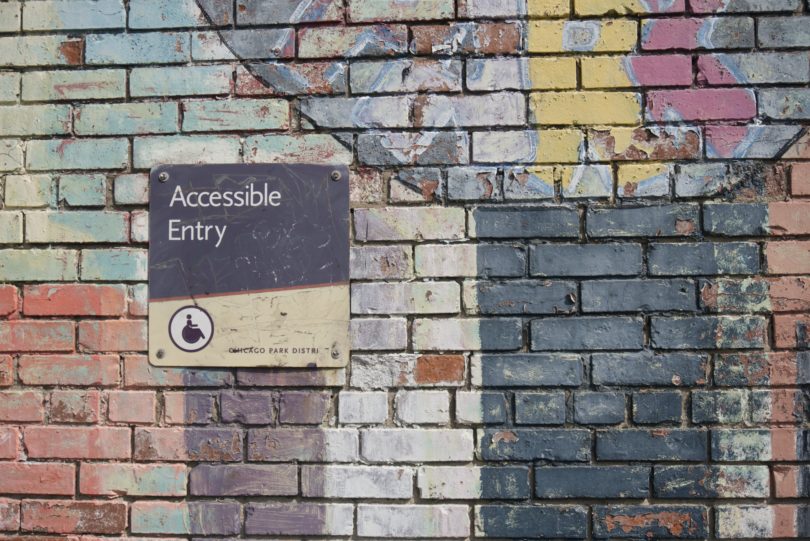It’s believed that 3.96 million Australians live with a disability. That’s almost 20% of the entire population.
With such a large number, it’s important that you know how to accommodate team members who live with a disability.
Under the Disability Discrimination Act 1992, workplaces need to make reasonable adjustments in the workplace for employees with disabilities. It’s not always about major changes like ramps and disabled toilets. It can also include small adjustments that might also make things easier for yourself.
There are a number of ways you can make your organisation more accessible, without having to renovate your entire office space. Here are some tips for your organisation to help build a more inclusive workplace.
Accessibility is for everyone
Berkeley, California was the first city to make curb cuts (or as we call them down under, kerb ramps) standard for all footpaths. Instead of a straight drop, all new footpaths near crossings would gently slope down.
The idea was to make the city more accessible to wheelchair users. After a couple of months however, city officials noticed something strange: many residents who didn’t live with disabilities were using the new curb ramps. This included people pushing shopping trolleys, parents with prams, cyclists, and delivery workers. While originally an accessibility feature, the new ramps wound up benefiting everyone.
The Curb-Cut Effect (as it came to be known) describes situations just like this, where features that were designed to help people living with disability end up making life easier for everyone else.
Measures to increase participation in the workforce can also be a boon to the rest of your small business. Ramps can make life easier for delivery drivers. Accessibility software can help team members who might not be as comfortable with computers. Flexible work arrangements can benefit parents.
Long story short, accessibility is for everyone, and not just people with disabilities!
4 simple ways you can make your workplace more accessible overnight
1. Rearrange the furniture
Not all accessibility improvements need to involve major renovations – in fact, sometimes it can be as simple as just moving things around!
One way to make the office more accessible immediately is to get creative with how the office is laid out to create wider spaces, which can help accommodate team members who use wheelchairs or who may need space for other assistive tools.
Even something as simple as reassigning desks so that employees with disabilities are closer to the entrance and have less distance to travel.
It’s a small change, but it can often make a world of difference.
2. Think about digital accessibility
Not all disabilities are physical. Many Australians live with visual, auditory, or cognitive difficulties that can make it difficult to use a computer.
Luckily, both Macs and Windows PCs now come with a host of built-in accessibility features. such as:
- Larger text and font options
- Colour-blind modes
- Screen reader programs
- Voice dictation
- Support for eye-tracking devices
A lot of additional programs and software have their own accessibility features, and there are plenty of third-party add-ons and programs you can install.
Depending on your employees’ needs, these features can be a big help, so be sure to ask about them. And best of all, many of these features work out of the box, saving you from having to book an appointment with your IT provider.
3. Be flexible
COVID-19 has forced many Australian small businesses to change how, when, and where they operate in order to protect their teams and adhere to social distancing requirements.
The shift to flexible working arrangements hasn’t all been bad news. In fact, there are some distinct silver linings such as catching up on sleep without the daily commute!
However, it’s been especially helpful for people living with a disability.
Being flexible with working arrangements means that workers can take time to see support providers like occupational therapists. It also reduces the need to travel to and from work, which can make life easier for many people who live with disability.
There’s another benefit too. Australia’s National Disability Insurance Scheme funds a range of support for participants, including extensive NDIS home modifications. These can make a big difference – they might not be feasible for all small businesses to implement.
By letting employees exercise the WFH option, employees with disabilities can work in an environment that’s already set up to accommodate them, and make use of the modifications and assistive technology they already have.
4. Talk to your team
Building an inclusive, accessible workplace requires a team effort. All the assistive tools and accessibility features can’t change a hostile workplace. For your small business to be truly inclusive, the rest of your team will need to be 100% onboard as well.
Many of your team members might feel daunted by the idea of working with someone who lives with a disability. They may be worried about saying the wrong thing and causing offence, or be unsure of what to expect.
Having a conversation with your team, explaining what accessibility measures you’ve taken, and busting myths can go a long way towards making your workplace more accessible and welcoming.
Laying the groundwork: how to conduct an accessibility audit
Before you can start looking at ways to make your workplace more accessible, you first need to figure out what sort of accessibility challenges your workplace may present.
That means taking stock of how accessible your business is currently.
This goes beyond looking at things like staircases or wheelchair ramps. There are many different types of disability, each of which have their own unique accessibility requirements. For example, people with vision impairments may need Braille signage.
As part of your audit, you’ll also want to assess how your workplace performs with a range of different types of disability. Start by taking stock of common disabilities. In addition to physical disability, be sure to account for things like vision impairment, psychosocial conditions and sensory impairments.
Using this information, start listing the sorts of accessibility problems they might face, as well as what you can reasonably do to accommodate them and make your workplace more accessible.
Each person’s case is unique, so it’s a good idea to talk to the employee in question to determine what they need, and what you can do to accommodate them. If you can ask this early on during the interview process, all the better.
In summation
People with disability face many obstacles in employment. As a small business owner, you have the power to bring some of those barriers down – and that doesn’t necessarily mean making big, sweeping changes!
Making your small business more accessible benefits everyone, and can start with small, common-sense measures.
The exact accommodations you make will depend on your space, your work, and your employees’ needs.
“The opinions expressed by BizWitty Contributors are their own, not those of BizCover and should not be relied upon in place of appropriate professional advice. Please read our full disclaimer."







